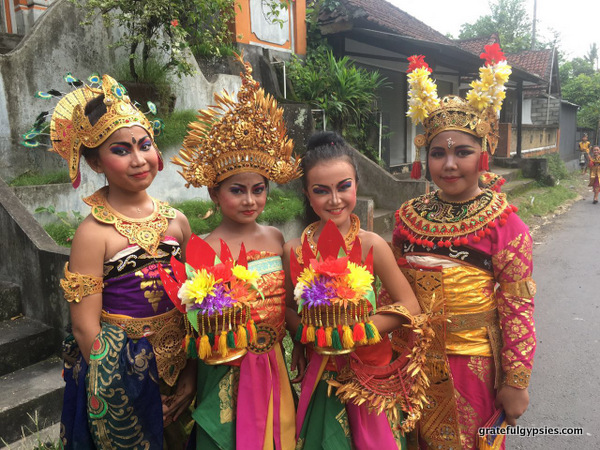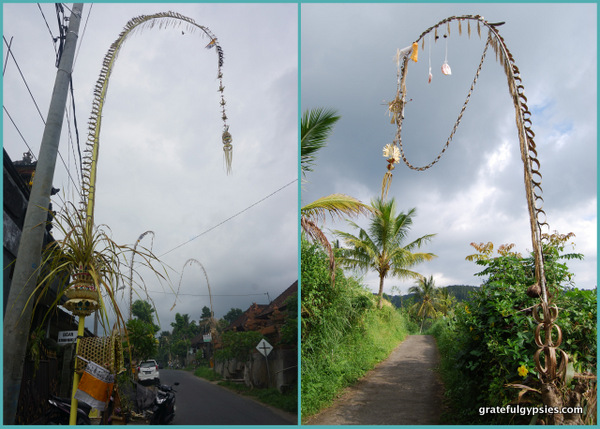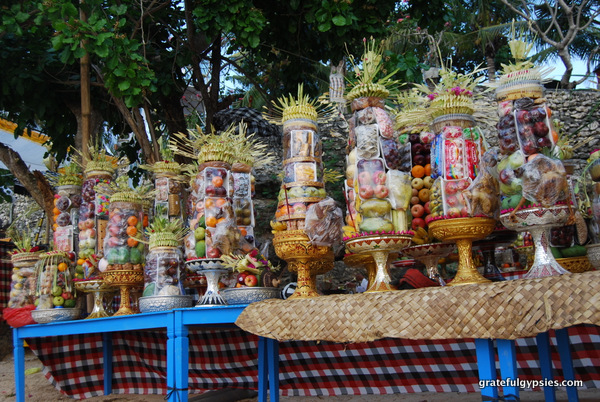Balinese Culture – Galungan and Kuningan Posted by sasha on Feb 25, 2016 in Uncategorized
Anyone who visits Bali will most likely see some kind of ceremony at some point in their trip. Whether at temples, at home, or in the village, it seems like there’s always some kind of ceremony going on. There are certain times of the year, however, when the ceremonies and processions are especially elaborate and important. One such time is the holiday of Galungan, which lasts for ten days and culminates with the day of Kuningan. The ceremonies that occur during this period are considered to be among the most important according to Balinese Hinduism, right up there with the New Year holiday of Nyepi. Here’s a quick introduction to this 10-day celebration that is a defining element of Balinese culture:
Background

Dressed up and ready for Galungan.
Galungan celebrates the victory of dharma (good) over adharma (evil), and the date is calculated according to the 210-day Balinese calendar. As a result, it happens twice every year. Celebrations just wrapped up on February 20th, and the whole thing will happen again beginning on September 7th. It is believed that the spirits of the deceased who have been cremated return home at this time. In order to be hospitable to the visiting spirits, many prayers and offerings will be made.

The penjor that come up all over Bali.
The most notable symbol of Galungan are the large decorative bamboo poles known as penjor that are erected in front of homes all over the island. These are decorated with fruit, flowers, and other offerings. The final day is known as Kuningan, and this is the day where spirits return to heaven.
Activities

Pig slaughters are very common. Sorry, vegans…
Although the holiday officially stretches over ten days, preparations begin weeks in advance. There’s lots to do before, during, and even after the holiday. The Balinese are known for their very colorful and artistic offerings, but they really go above and beyond for Galungan. Just take a look at a row of offerings at a ceremony on Nusa Lembongan:

Elaborate offerings for Galungan.
Here are some important days associated with Galungan and the customs for each one:
- 3 days before = Penyekeban: Covering of green bananas for ripening
- 2 days before = Penyajaan: Making of jaja (fried rice cakes)
- 1 day before = Penampahan: Slaughtering of animals (usually pigs)
- Galungan Day: Visiting temples, making offerings and prayers
- 1 day after = Manis Galungan: Visiting family and friends for fun.
- 10 days after = Kuningan: Making of yellow rice offerings and visiting temples.

Temples will be covered in canang sari offerings at this time.
And you thought you had it tough cooking a turkey or doing Christmas shopping! Balinese holidays really do require a lot of preparation and effort. Getting ready for Galungan and performing all the ceremonies and offerings that come along with it are a major expense for most families – both of time and money.
Ngelawang Ceremony
Throughout Galungan, a special ceremony occurs in villages called Ngelawang. The ceremony is performed by a barong – a mythical beast and protector. The barong will parade through the village and visit homes, usually accompanied by children and the sounds of gamelan music. This will restore the balance of good and evil, and it’s customary to make offerings after the barong visits.
Galungan Video
To get a better idea of what it’s like in Bali during this time, check out this short YouTube video. It’s a bit old, but having just witnessed the holiday this past week I can tell you that not much has changed in terms of how the Balinese celebrate Galungan.
Should you find yourself in Bali during this special time, be sure to enjoy the festive atmosphere. Just remember to be respectful – it’s a very sacred holiday of deep spiritual significance. Do not enter a temple during a ceremony unless invited by a local, and be sure to dress and act appropriately. Whether or not this happens, you’re sure to see processions through the streets and countless colorful penjor billowing in the wind. Galungan and Kuningan may be finished for the time being, but there’s always another ceremony around the corner in Bali.

Build vocabulary, practice pronunciation, and more with Transparent Language Online. Available anytime, anywhere, on any device.
About the Author: sasha
Sasha is an English teacher, writer, photographer, and videographer from the great state of Michigan. Upon graduating from Michigan State University, he moved to China and spent 5+ years living, working, studying, and traveling there. He also studied Indonesian Language & Culture in Bali for a year. He and his wife run the travel blog Grateful Gypsies, and they're currently trying the digital nomad lifestyle across Latin America.



